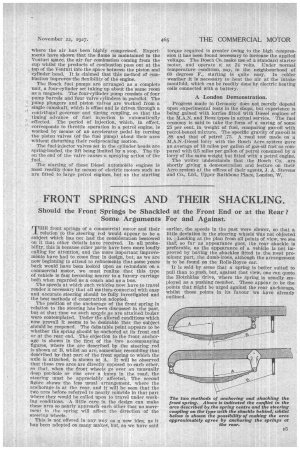FRONT SPRINGS AND THEIR SHACKLING.
Page 131

If you've noticed an error in this article please click here to report it so we can fix it.
Should the Front Springs be Shackled at the Front End or at the Rear ? Some Arguments For and Against.
THE front springs of a commercial motor and their relation to the steering rod would appear to be a subject which has not had the consideration bestowed on it thatother details have received. In all probability, this is because other parts have been more loudly calling for attention, and the more important improvements have had to come first in design, but, as we are now beginning to attend to refinements that some years back would have been looked upon as redundant on a commercial motor, we must realize that this type of vehicle is fast becoming nearer to a luxury carriage both when regarded as a coach and as a bus.
The speeds at which such vehicles now have to travel render it necessary that all matters connected with easy and accurate steering should be fully investigated and the best methods of construction adopted.
The position of the anchorage of the front spring in relation to the steering has been discussed in the past, but at that time no such speeds as are attained foslay were contemplated. Under the altered conditions which now prevail it seems to be desirable that the subject should be reopened. The debatable point appears to be whether the spring should be anchored at its front end or at the rear end. The objection to the front anchorage is shown in the first a the two accompanying figures, where the arc described by the steering rod is shown at B, whilst an arc, somewhat resembling that described by that part of the front spring to which the axle is attached, is shown at A. It will be observed that these two arcs are directly opposed to each other, so that, when the front wheels go over an unusually deep pot-hole or rise over a hump in the road, the steering must be appreciably affected. The second figure shows the less usual arrangement, where the anchorage is at the rear, and it will be seen that the two arcs before referred to nearly coincide in that part where they would be called upon to travel under working conditions. A little care in the design can make these arcs so nearly approach each other that no movement in the spring will affect the direction of the steering wheels.
This is not offered in any way as a new idea as it has been adopted on many makes, but, as we have said
earlier, the speeds in the past were slower, so that a little deviation in the steering wheels was not objected to. Looking at the plan from all points of view, we see that, so far as appearance goes, the rear shackle is preferable, as the appearance of a vehicle is not improved by having the shackles fitted to the most prominent part, the dumb-irons, although the arrangement is to be found on the Rolls-Royce car.
It is said by some that a spring is better suited to pull than to push, but, against that view, one can quote the Hotchkiss drive, where the spring is usually employed as a pushing member. These appear to be the points that might be urged against the rear anchorage, whilst those points in its favour we have already outlined.


















































































































































































































































































































